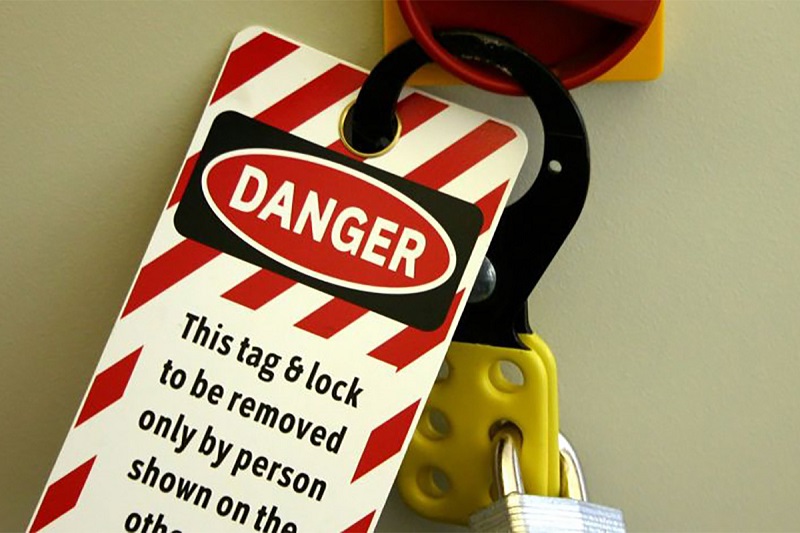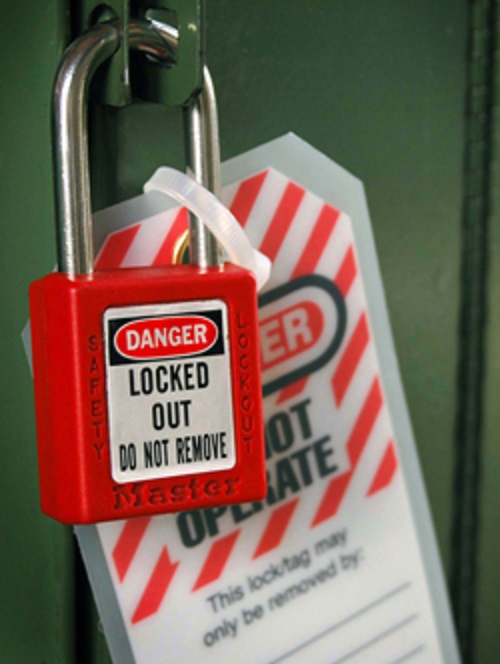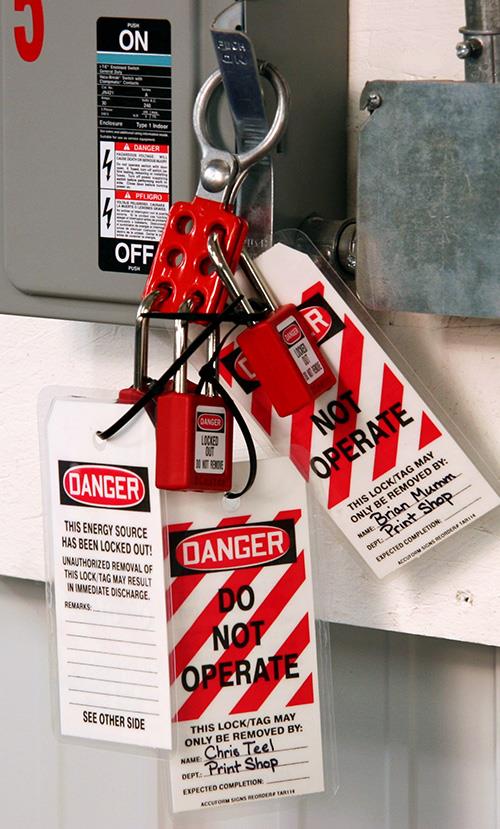An operating machine comes with its own risks and hazards, but it can also compromise occupational safety when it’s off if it stores energy such as electricity, gas, pressurized water or compressed air – so, a lock out tag out procedure is necessary.
Lock out tag out procedures control hazardous energy in the workplace when machinery isn’t operational, for example, during maintenance.
The OSHA standards of lock out/tag out procedures protect workers, and violations can result in fines and penalties.
We’ve compiled this guide for employers to learn what lockout/tagout procedures entail and how to implement them in the workplace.

What Is a Lockout Procedure?
The lockout of a machine is an energy control program that physically locks the machine to prevent hazardous energy release. Locking the machine isolates energy sources from the system, so the machine is safe to use.
It also prevents the spontaneous or accidental activation of machinery.
The energy-isolating device can include:
- a disconnect switch that’s operated manually,
- a circuit breaker,
- a line valve, or
- a blocker.
What Is a Tagout Procedure?
Once a lockout procedure has been performed, a tagout procedure must be done immediately.
This is a process of labelling or tagging the machine to indicate that it has been locked.
The tag should include:
- why the machine is being locked,
- the time the lock was applied, and
- the name of the authorized employee who locked the machine.
Who May Perform a Lockout/Tagout Procedure?
Only an authorized employee may lock and tag machines if they are assigned to do so.
Authorized employees are those qualified, through training and experience, to control hazardous energy.
While any authorized person can perform a lockout/tagout procedure, only the same individual who put the procedure into place is permitted to unlock the machine and remove the tag. This protects the authorized employee from being at risk of unexpected energization should someone else activate the machinery.

What Are the Steps To Perform a Lockout/Tagout Procedure?
Step 1: Preparation
The authorized employee must establish the hazardous energy that needs to be controlled and identify the correct energy isolating devices to be used for tagout.
Step 2: Notify Affected Employees
The authorized person must communicate to any affected employees that the lockout/tagout procedure is about to occur. Affected employees are those who may be working within the area of the machine needing service or maintenance, thus requiring the control of hazardous energy.
Step 3: Machine Shutdown
The machine must be safely shut down according to the manufacturer instructions. All moving parts must come to a complete stop.
Step 4: Isolate Hazardous Energy Sources
Hazardous energy sources must be restricted from the machine. Each type of energy will have different ways to do so:
- electrical energy: flipping the switch into “off” position
- hydraulic, pneumatic and chemical energy: closing the valves.
Step 5: Apply Energy Isolating Devices
Now it is safe for the authorized employee to perform the lockout/tagout procedure.
Each hazardous energy source must have its own lock with only one key, so no master keys.
Once the energy source is properly locked, the tag must be filled out and situated on the equipment.
Step 6: Release Stored Energy
Releasing stored energy or residual energy is an important part of controlling hazardous energy that shouldn’t be overlooked, as it can still be dangerous to workers’ occupational health and safety.
Heat may be trapped in a thermal system, and fumes might need to be vented. Any compressed springs need to be released, and parts of the machine that may fall or move need to be blocked or supported.
Step 7: Verify Lockout
Before maintenance activities can begin, the lockout/tagout must be verified. All hazardous energy must be locked away, and the lock must be secure.
Lockout/tagout inspection can be done visually and by testing the equipment to ensure safety.
Step 8: Maintain Lockout
Authorized workers may now perform maintenance.
If the shift is over before maintenance on the equipment is complete, the locks and tagout labels must remain. This will provide awareness on the servicing taking place and prevent operators and workers on duty during the next shift from using the locked equipment.
Locks and tags may only be removed by the authorized worker who instated them once the maintenance is complete.

How Insure Compliance Can Help Your Company With Lockout/Tagout Procedures
We help companies achieve OSHA safety compliance while simultaneously maintaining a positive safety culture.
So, the employer is happy they won’t be fined for violations, and the employees are happy they’re being taught how to work safely and with less risk.
To do this, we use our proven Safety Gap Model and perform a gap analysis in your company.
Gaps or weak links that can result in low safety culture include:
- awareness gap: knowing what the lockout/tagout procedures are and why they exist,
- process gap: drafting the lockout/tagout procedures manual for authorized workers,
- knowledge gap: training authorized workers using the manual,
- verification gap: ensuring procedures are maintained, and
- accountability gap: holding authorized workers accountable for violating procedures.
We can perform our safety assessment to establish your gaps and provide guidance for you as the employer with establishing the lockout/tagout procedure manual. Then, we can train your employees accordingly and even perform a mock OSHA audit after a few weeks.
Key Takeaways
A lockout procedure is an action of locking equipment to ensure hazardous energy remains inside.
A tagout procedure is then performed by attaching a label on the locked equipment to indicate it’s not functioning.
Lockout/tagout procedures may only be performed by authorized personnel who have been trained to do so.
They should begin by establishing the correct lockout procedures depending on the energy present. Other workers must be notified of the machine shut down, and then it may be de-energized.
The hazardous energy sources must be isolated and then locked. Stored energy must be released and locks must be double-checked.
Locks are not allowed to be removed until the maintenance is fully completed. Only the authorized individual who instated the lock may remove it.
If you need any guidance navigating lockouts and tagouts, contact Insure Compliance today. We’ll help you reach OSHA standards so you and your team have nothing to worry about.
Disclaimer:
Please note that every effort has been made to ensure that the information provided in this guide is accurate. You should note, however, that the information is intended as a guide only, providing an overview of general information available to businesses. This guide is not intended to be an exhaustive source of information and should not be seen to constitute legal, safety or business advice. You should, where necessary, seek your own advice for any issues raised in your affairs.







